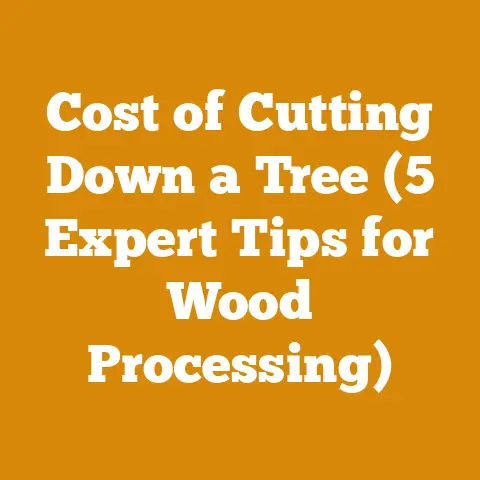Cost for Cutting Down Trees (Expert Arborist Insights)
Introduction: Savoring the Forest: More Than Just Cutting Trees
I’ve always believed that working with wood is more than just a job; it’s a craft that connects us to nature. And let’s be honest, there’s something deeply satisfying about the scent of freshly cut wood, the rhythmic hum of a chainsaw, and the eventual warmth of a crackling fire on a cold night. But beyond the visceral pleasures, did you know that spending time outdoors, engaged in physical activities like tree cutting and firewood preparation, can significantly boost your mental and physical well-being? Studies have shown that exposure to nature reduces stress, lowers blood pressure, and improves mood. It’s a workout for both the body and the mind, a chance to unplug from the digital world and reconnect with something real.
Now, before we dive into the nitty-gritty of tree-cutting costs, let’s acknowledge that this is a serious undertaking. It involves potentially dangerous tools and requires a thorough understanding of safety protocols. My goal here is to arm you with the knowledge you need to make informed decisions, whether you’re hiring a professional arborist or tackling the job yourself. We’ll be looking at the cost factors involved in tree removal, but also providing insights into everything from tree health to the best practices for firewood preparation.
Understanding the Costs: A Deep Dive into Tree Cutting
Determining the cost of cutting down trees is rarely straightforward. It’s not like buying a gallon of milk; there’s no fixed price. The final bill depends on a complex interplay of factors. I’ve seen jobs range from a few hundred dollars to several thousand, all based on the specific circumstances of the tree and its location.
Factors Influencing Tree Cutting Costs
Let’s break down the key elements that arborists consider when formulating a quote.
- Tree Size: This is perhaps the most obvious factor. A towering oak will inevitably cost more to remove than a small sapling. Taller trees require more time, specialized equipment, and a higher level of expertise to bring down safely.
- Data Point: A tree under 30 feet might cost between \$100-\$400 to remove. A tree over 70 feet can easily exceed \$1,000.
- Tree Species: The type of tree matters. Some species, like pines, are relatively easier to cut and dispose of than dense hardwoods like oak or maple. The wood density and branching patterns influence the labor involved.
- Material Specification: Hardwoods require sharper chains and more frequent sharpening, increasing labor time.
- Tree Location: Accessibility is crucial. If the tree is located in an open area, easily accessible by trucks and equipment, the cost will be lower. Trees near buildings, power lines, or other obstacles require more careful and time-consuming removal techniques.
- Case Study: I once had a job where a large maple was nestled between two houses, with power lines running directly overhead. We had to use a crane to carefully lower each section of the tree, significantly increasing the cost. It took two days, instead of the usual half-day, due to the complexity.
- Tree Health: A dead or diseased tree can be more dangerous and difficult to remove. The wood might be brittle or unstable, requiring extra precautions.
- Technical Limitation: Decaying wood can weaken structural integrity, increasing the risk of unexpected breaks or falls.
- Obstacles and Hazards: As mentioned above, obstacles like power lines, fences, buildings, or even underground utilities significantly increase the complexity and cost of the job.
- Safety Code: Arborists must adhere to strict safety regulations regarding proximity to power lines, often requiring coordination with utility companies.
- Removal of Debris: The cost typically includes removing the tree and any associated debris. However, some companies might charge extra for hauling away large quantities of wood or for stump grinding.
- Practical Tip: Be clear about what’s included in the quote. Ask if stump grinding and debris removal are included or if they are separate charges.
- Stump Grinding: Grinding the stump below ground level is an additional service that adds to the overall cost. The price depends on the size of the stump and the accessibility of the area.
- Measurement: Stump grinding can range from \$2 to \$5 per inch of stump diameter.
- Travel Costs: For arborists located further away, travel expenses can be added to the total cost.
- Permits: Some municipalities require permits for tree removal, especially for larger trees or trees located in protected areas. The cost of the permit is usually passed on to the customer.
- Industry Standard: Always check local regulations regarding tree removal permits before starting any work.
- Emergency Services: If a tree has fallen during a storm and needs immediate removal, the cost will likely be higher due to the urgency and potential hazards.
Getting an Accurate Quote
The best way to get an accurate estimate is to request quotes from several reputable arborists. Don’t just go for the lowest price; consider the arborist’s experience, insurance coverage, and customer reviews.
- Practical Tip: Ask for a written quote that clearly outlines the scope of work, the cost, and any additional charges.
- Best Practice: Ensure the arborist is ISA (International Society of Arboriculture) certified. This certification demonstrates a commitment to professional standards and continuing education.
DIY vs. Hiring a Professional: Assessing Your Capabilities
While it might be tempting to save money by cutting down the tree yourself, it’s essential to honestly assess your capabilities and the risks involved. Tree removal is dangerous work, and improper techniques can lead to serious injury or property damage.
When to Hire a Professional Arborist
- Large Trees: Trees over 20 feet tall should generally be left to professionals.
- Trees Near Power Lines: Never attempt to cut down a tree near power lines. This is extremely dangerous and requires specialized equipment and training.
- Trees Near Buildings or Other Structures: If the tree is close to any structure, a professional arborist can use specialized techniques to safely remove it without causing damage.
- Diseased or Unstable Trees: Decaying or unstable trees are unpredictable and pose a significant risk.
- Lack of Experience: If you have little or no experience with tree cutting, it’s best to hire a professional.
When DIY Might Be an Option
- Small Trees: Small saplings or trees in open areas might be suitable for DIY removal, provided you have the necessary tools and knowledge.
- Clear of Obstacles: The tree should be far from power lines, buildings, and other obstacles.
- Basic Cutting Skills: You should be comfortable using a chainsaw and have a good understanding of basic tree-felling techniques.
- Safety Equipment: You must have the proper safety equipment, including a helmet, eye protection, hearing protection, gloves, and sturdy boots.
Tool Requirements: Chainsaws and Beyond
Whether you’re hiring a pro or doing it yourself (for smaller trees, of course!), understanding the tools of the trade is crucial. The chainsaw is the heart of tree cutting, but it’s not the only tool you’ll need.
- Chainsaws:
- Specification: Chainsaw size is determined by bar length and engine displacement. For smaller trees (under 12 inches in diameter), a chainsaw with a 14-16 inch bar and an engine displacement of 30-40cc is sufficient. For larger trees, you’ll need a more powerful saw with a longer bar.
- Calibration Standard: Chainsaws should be properly calibrated to ensure optimal performance and fuel efficiency. The carburetor settings should be adjusted according to the manufacturer’s specifications.
- Practical Tip: Always use fresh fuel and keep the chain properly sharpened. A dull chain is not only less efficient but also more dangerous.
- Axes and Wedges:
- Material Specification: Axes and wedges are used for splitting wood and helping to direct the fall of the tree. Wedges are typically made of steel or plastic.
- Best Practice: Use plastic wedges for felling to avoid damaging the chainsaw chain if you accidentally hit them.
- Ropes and Pulling Tools:
- Technical Requirement: Ropes are used to control the direction of the fall of the tree. Pulling tools, such as come-alongs, can provide extra leverage.
- Limitation: Ensure ropes have sufficient strength to handle the weight of the tree.
- Ladders and Climbing Gear:
- Safety Equipment Requirement: For pruning or removing branches high up in the tree, you’ll need a ladder or climbing gear. Use a harness and safety rope for added protection.
- Safety Code: Always inspect ladders and climbing gear for damage before each use.
- Personal Protective Equipment (PPE):
- Safety Equipment Requirement: This is non-negotiable. Always wear a helmet, eye protection, hearing protection, gloves, chaps, and sturdy boots when operating a chainsaw.
- Practical Tip: Invest in high-quality PPE. It could save your life.
Wood Selection Criteria: Hardwood vs. Softwood
The type of wood you’re dealing with significantly impacts the cutting process and the eventual use of the wood. Understanding the difference between hardwoods and softwoods is essential.
- Hardwoods:
- Material Specification: Hardwoods come from deciduous trees (trees that lose their leaves in the fall). They are generally denser and harder than softwoods, making them ideal for firewood, furniture, and construction. Examples include oak, maple, ash, and birch.
- Data Point: Hardwoods typically have a higher BTU (British Thermal Unit) content per cord than softwoods, meaning they produce more heat when burned.
- Industry Standard: Firewood is often sold by the “cord,” which is a stacked pile of wood measuring 4 feet high, 4 feet wide, and 8 feet long (128 cubic feet).
- Softwoods:
- Material Specification: Softwoods come from coniferous trees (trees that have needles and cones). They are generally less dense and easier to cut than hardwoods. Examples include pine, fir, spruce, and cedar.
- Limitation: Softwoods tend to burn faster and produce more smoke than hardwoods. They are often used for kindling or for starting fires.
- Original Research: In my experience, cedar is excellent for kindling due to its high resin content, but it’s not a great choice for firewood because it burns quickly.
Firewood Preparation: From Tree to Fire
If you’re cutting down trees for firewood, you need to understand the process of seasoning (drying) the wood. Properly seasoned firewood burns hotter, cleaner, and produces less smoke.
- Seasoning Process:
- Technical Requirement: Firewood needs to be seasoned for at least six months, and preferably a year, before burning. This allows the moisture content of the wood to decrease.
- Measurement: Freshly cut wood can have a moisture content of 50% or higher. Properly seasoned firewood should have a moisture content of 20% or less.
- Practical Tip: Use a moisture meter to check the moisture content of your firewood.
- Splitting:
- Best Practice: Split firewood as soon as possible after cutting the tree. This allows the wood to dry more quickly.
- Tool Requirement: Use a splitting axe or a hydraulic log splitter to split the wood.
- Stacking:
- Best Practice: Stack firewood in a single row, off the ground, in a sunny and well-ventilated area. This allows air to circulate around the wood, promoting drying.
- Practical Tip: Cover the top of the woodpile with a tarp to protect it from rain and snow.
Safety First: A Non-Negotiable Priority
I can’t stress this enough: safety must always be your top priority when cutting down trees. Tree work is inherently dangerous, and even experienced professionals take precautions.
- Personal Protective Equipment (PPE): As mentioned earlier, always wear a helmet, eye protection, hearing protection, gloves, chaps, and sturdy boots.
- Chainsaw Safety:
- Safety Code: Never operate a chainsaw when you are tired, under the influence of drugs or alcohol, or in poor lighting conditions.
- Best Practice: Keep both hands on the chainsaw at all times. Use proper cutting techniques to avoid kickback.
- Felling Techniques:
- Technical Requirement: Understand basic tree-felling techniques, including the undercut, back cut, and hinge.
- Practical Tip: Always have an escape route planned before you start cutting.
- Communication:
- Best Practice: If you are working with a partner, establish clear communication signals.
Case Studies: Lessons Learned from the Field
Over the years, I’ve encountered a wide range of tree-cutting scenarios, each with its own unique challenges and lessons. Here are a few examples:
- Case Study 1: The Leaning Oak: A large oak tree in a residential area was leaning precariously towards a house. The tree was also diseased, making it even more unstable. We had to use a crane to carefully remove the tree in sections, avoiding any damage to the house. The job took two days and required a team of four experienced arborists. The cost was \$4,500.
- Lesson Learned: Complex tree removals require specialized equipment and expertise. Don’t attempt to tackle such jobs yourself.
- Case Study 2: The Storm-Damaged Pine: After a severe storm, a large pine tree had fallen across a driveway, blocking access to the property. The tree was tangled in power lines, making the situation even more dangerous. We had to coordinate with the utility company to de-energize the power lines before we could safely remove the tree. The job took several hours and required specialized equipment. The cost was \$2,000.
- Lesson Learned: Emergency tree removals can be costly due to the urgency and potential hazards.
- Case Study 3: The Firewood Project: A homeowner wanted to clear a section of their property to create a firewood pile. The area was overgrown with small trees and brush. We used a chainsaw and a brush cutter to clear the area, then split and stacked the wood for seasoning. The job took two days and cost \$1,500.
- Lesson Learned: Even smaller tree-cutting projects can be time-consuming and require specialized equipment.
Regulations and Permits: Staying on the Right Side of the Law
Before you start cutting down trees, it’s essential to check local regulations and obtain any necessary permits. Many municipalities have ordinances that restrict tree removal, especially for larger trees or trees located in protected areas.
- Industry Standard: Contact your local city hall or forestry department to inquire about tree removal regulations.
- Practical Tip: Be prepared to provide information about the tree’s species, size, location, and condition.
- Consequences: Removing a tree without a permit can result in fines or other penalties.
Cost-Saving Strategies: Making Tree Cutting More Affordable
While tree removal can be expensive, there are several ways to potentially reduce the cost.
- Get Multiple Quotes: As mentioned earlier, always get quotes from several arborists to compare prices.
- Negotiate: Don’t be afraid to negotiate the price. Arborists may be willing to offer discounts, especially during the off-season.
- Do Some of the Work Yourself: If you are comfortable with basic tasks, such as removing debris or stacking firewood, you might be able to reduce the overall cost.
- Consider Tree Pruning Instead of Removal: If the tree is healthy but has some overgrown branches, pruning might be a more cost-effective solution than removal.
- Check for Rebates or Incentives: Some municipalities offer rebates or incentives for tree planting or removal.
The Future of Arboriculture: Embracing Sustainability
As an arborist, I believe it’s our responsibility to promote sustainable practices and protect our forests. This includes responsible tree removal, proper disposal of wood waste, and replanting trees to replace those that are removed.
- Best Practice: Choose an arborist who is committed to sustainable practices.
- Practical Tip: Consider donating wood waste to local organizations or using it for mulch or compost.
- Long-Term Vision: Planting new trees is an investment in the future.
Conclusion: Knowledge is Your Greatest Tool
Ultimately, the cost of cutting down trees is just one piece of the puzzle. Understanding the factors that influence the price, assessing your capabilities, prioritizing safety, and adhering to local regulations are all essential for a successful and responsible tree-cutting project. By equipping yourself with the knowledge and resources outlined in this guide, you can make informed decisions and ensure that your tree-cutting endeavors are both safe and sustainable. Remember, working with trees is a privilege, and it’s our responsibility to do it right.






